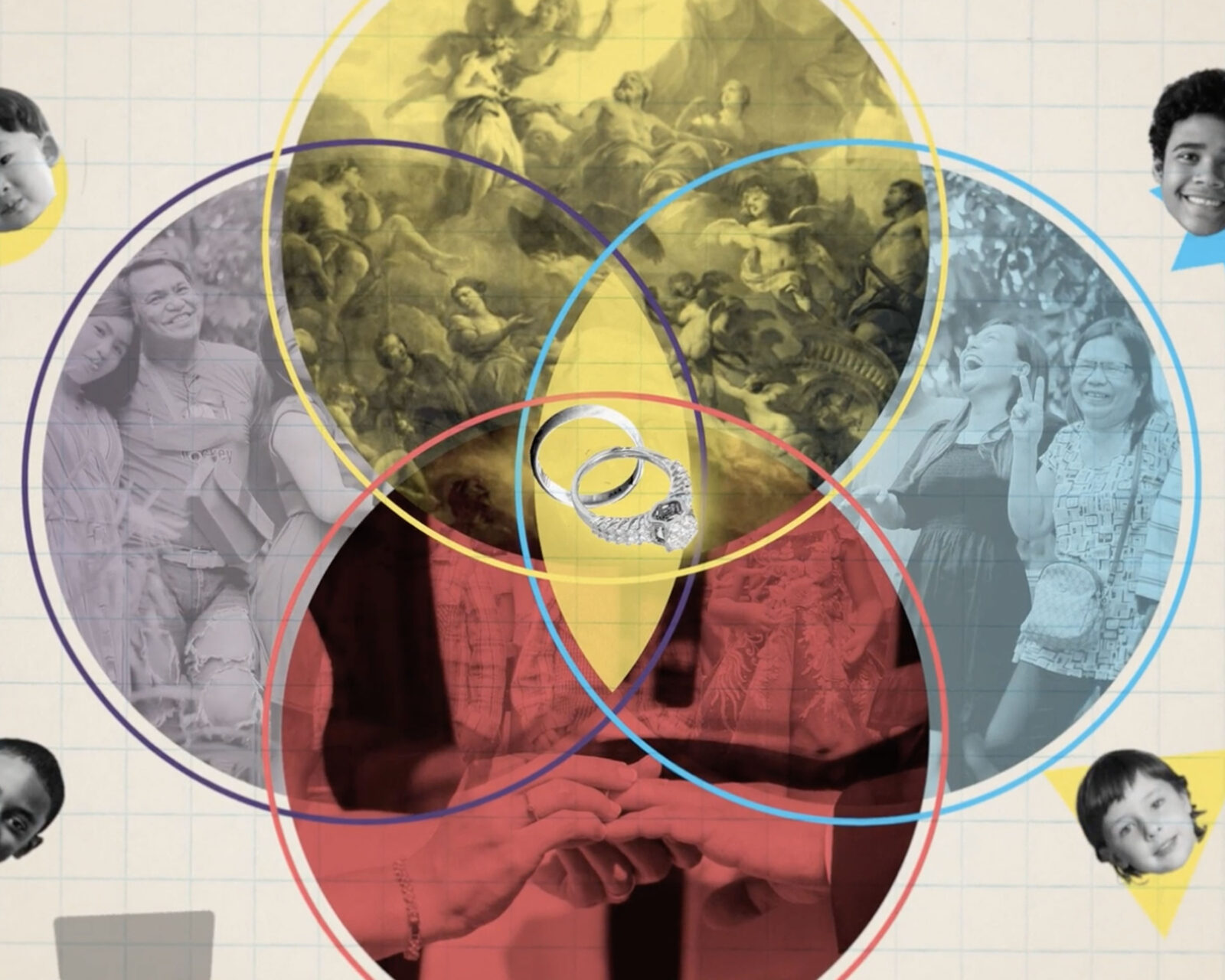Commitments vs promises: what’s the difference?
Proclamation

Our society is built on promises. Families and marriages are the building blocks of societies. Marriages are one of the most meaningful promises or oaths we can make today.
WatchThe Catholic Church cares about marriages, and has the authority to determine if a marriage is valid or not based on a set of criteria.
Proclamation

Our society is built on promises. Families and marriages are the building blocks of societies. Marriages are one of the most meaningful promises or oaths we can make today.
WatchExplanation

In marriage, Jesus gives spouses sacramental grace to take up their crosses and follow Him. By this grace, spouses learn to lay down their lives for each other and for…
WatchConnection

The Church calls the exchange of vows consent—that is, the act of will by which a man and a woman give themselves to each other, and accept the gift of…
WatchEdmund: Hey, do you know what this is? It’s actually, despite how it looks, not a ninja weapon, but it has to do with marriage. And it’s gonna help us today understand what are annulments in the Catholic Church. So my friends got this for me when they went on a mission trip. So this is actually a carving of a husband and wife who are kneeling down, praying, and it’s, they’re bound by this chain here. This is called a marriage chain. And you might not know just by looking at it, but this was carved out of a single piece of wood. These chains here have never been broken. This marriage chain reminds us of the permanence of marriage. The Catechism reminds us in paragraph 1646. It says this, “By its very nature, conjugal love requires the inviable fidelity of the spouses. This is the consequence of the gift of themselves which they make to each other. Love seeks to be definitive. It cannot be an arrangement until further notice. The intimate union of marriage as a mutual giving of two persons and the good of the children demand total fidelity from the spouses and require an unbreakable union between them.” So it can be really confusing for people that the Catholic Church does not believe in divorce of marriages, but the Catholic Church does have what we call annulments. Now, this can be kind of confusing because the term annulment might not give us the best idea of what’s actually going on. Now, the Church does make a declaration of nullity, but it doesn’t mean that they’re nullifying the marriage. What they’re saying is that a valid marriage never took place to begin with. The Catechism reminds us in paragraph 1625, “The parties to a marriage covenant are a baptized man and woman free to contract marriage who freely express their consent. To be free means not being under constraint, not impeded by any natural or ecclesiastical law.” So for instance, if you tried to marry your dog, it’s not a human person. Or if you tried to marry someone who is currently married, or if you were threatened and coerced into marriage, those marriages would not be valid… meaning it’s impossible for that marriage to have ever existed. The things that stop a marriage from ever taking place are called impediments to marriage. And just like you couldn’t marry a tree, there are things that could stop a valid marriage from taking place. And just in the same way the State has requirements for civil marriages, the Catholic Church has requirements for what constitutes a valid marriage. So there are four things that constitute a valid marriage. Firstly, the spouses have to be free to marry. Secondly, they have to exchange their consent to marriage freely. Thirdly, they have to have the intention to marry for life, to be open to children and to be faithful to one another. And lastly, their consent to one another has to be given in front of at least two witnesses and an authorized minister of the Church. So the Church always assumes that a marriage is valid, but there is a process by which the Church discerns and looks to see if a marriage had ever been entered into in the first place, meaning that that marriage was valid.
An annulment is a declaration by a tribunal, which is kind of like a Catholic Church court that says that a marriage that was previously thought to be valid in the eyes of the Church and Church law has now been found to be invalid. And it means that the tribunal has found that there’s clear evidence that that marriage fell short of one of the essential requirements in order for two people to enter into a valid marriage. So again, unlike a civil divorce, an annulment is a declaration that something that was thought to exist never existed from the beginning. So let’s use the example of the marriage chain here. So you can imagine as someone’s learning how to carve one of these, that the first couple times it might not work, the chains might break. But if the wood carver has the necessary skills and capacity, he can create this marriage chain.
In a way, an annulment in the Church is like the Church discerning if this marriage chain was successfully made, divorce would be taking a successfully completed marriage chain like this and breaking the chains. Now a few important points: A declaration of nullity does not mean that a relationship never existed, that these two people didn’t love each other. And it also doesn’t mean that their children are somehow illegitimate. It doesn’t mean that their these children are unwanted or bad. It just means that these children were born under the assumption that this marriage was valid. All this should encourage and remind us that the sacrament of matrimony is not something we should take lightly. It’s something we should very seriously discern, and we should make sure that we have the capacity and the requirements for entering into a valid marriage. Because in the Sacrament of Matrimony, a man and woman are called to the love and union of spouses that reflects the blessed life of the Trinity.
U.30 — CCC 1716-1729

The catechism says the beatitudes are the heart of Jesus’ preaching that they reveal the goal of human existence.
WatchU.29 — CCC 2052-2082

While the Ten Commandments state grave obligations, they also imply other ways we should live out God’s law in less grave matters.
WatchU.28 — CCC 1949-2051

We are called to do our best, and rely on God for the rest. Jesus gives us the Holy Spirit, and the sacraments to give us strength.
WatchU.27 — CCC 1803-1948

“Trying harder next time” won’t keep you from sinning. You need to cooperate with grace!
WatchBy submitting this form you consent to receive emails about Real+True and other projects of OSV.